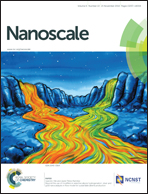Ultra-broadband unidirectional launching of surface plasmon polaritons by a double-slit structure beyond the diffraction limit†
Abstract
Surface-plasmon-polariton (SPP) launchers, which can couple the free space light to the SPPs on the metal surface, are among the key elements for the plasmonic devices and nano-photonic systems. Downscaling the SPP launchers below the diffraction limit and directly delivering the SPPs to the desired subwavelength plasmonic waveguides are of importance for high-integration plasmonic circuits. By designing a submicron double-slit structure with different slit widths, an ultra-broadband (>330 nm) unidirectional SPP launcher is realized theoretically and experimentally based on the different phase delays of SPPs propagating along the metal surface and the near-field interfering effect. More importantly, the broadband and unidirectional properties of the SPP launcher are still maintained when the slit length is reduced to a subwavelength scale. This can make the launcher occupy only a very small area of <λ2/10 on the metal surface. Such a robust unidirectional SPP launcher beyond the diffraction limit can be directly coupled to a subwavelength plasmonic waveguide efficiently, leading to an ultra-tight SPP source, especially as a subwavelength localized guided SPP source.



 Please wait while we load your content...
Please wait while we load your content...